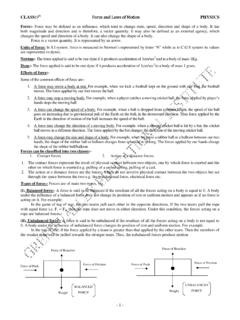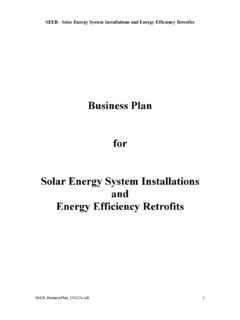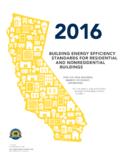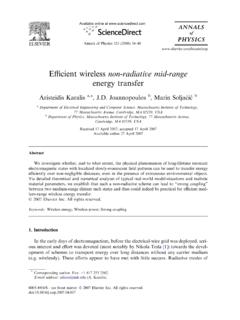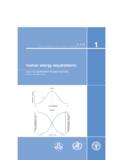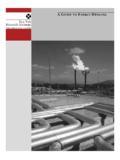Transcription of Class 10 th Energy - Green Valley Educational Institute
1 Class 10th SOURCES OF Energy PHYSICS. Energy : - Whenever a body is capable of doing work, the body is said to possess Energy . Thus Energy is defined as the ability of a body to do work and the amount of Energy possessed by a body is equal to the amount of work it can do when its Energy is released. Units of Energy : - On system, Energy is measured in the units of joules or in calories, and on system in ergs. However, the commercial unit of Energy is kilowatt-hour. The Energy is said to be one kilowatt-hour, when a body consumes one kilowatt of Energy in one hour. Sources of Energy : a source of Energy is that which is capable of providing enough useful Energy at a steady rate over a long period of time.
2 A good source of Energy should be : i) Safe and convenient to use, , nuclear Energy can be used only by highly trained engineers with the help of nuclear power plants. It cannot be used for our household purposed. ii) Easy to transport, , coal, petrol, diesel, LPG etc. Have to be transported from the places of their production to the consumers. iii) Easy to store, , huge storage tanks are required to store petrol, diesel, LPG etc. Characteristics of an ideal or a good fuel: 1. It should have a high calorific or a heat value, so that it can produce maximum Energy by low fuel consumption. 2. It should have a proper ignition temperature, so that it can burn easily.
3 ]. 3. It should not produce harmful gases during combustion. 4. It should be cheap in cost and easily available in plenty for everyone. 5. It should be easily and convenient to handle, store and transport from one place to another. 6. It should not be valuable to any other purpose than as a fuel. 7. It should burn smoothly and should not leave much residue after its combustion. Classification of sources Energy : The sources of Energy can be classified as follows : (i) Renewable (ii) Non-Renewable. 1. Renewable sources of Energy :- Renewable sources of Energy are those which are inexhaustible, , which can be replaced as we use them and can be used to produce Energy again and again.
4 These are available in an unlimited amount in nature and develop within a relatively short period of time. Examples of Renewable Sources of Energy . (i) Solar Energy , (ii) Wind Energy , (iii) water Energy (hydro- Energy ), (iv) geothermal Energy , (v) ocean Energy , (vi) biomass Energy (firewood, animal dung and biodegradable waste from cities and crop residues constitute biomass). Advantages of Renewable Sources of Energy : (i) These sources will last as long as the Earth receives light from the sun. (ii) These sources are freely available in nature. (iii) These sources do not cause any pollution. Page 1. Class 10th SOURCES OF Energy PHYSICS.
5 2. Non-Renewable Sources of Energy : Non-renewable sources of Energy are those which are exhaustible and cannot be replaced once they have been used. These sources have been accumulated in nature over a very long period of million of years. Examples of Non-renewable sources of Energy : (i) Coal (ii) Oil and (iii) Natural gas. All these fuels are called fossil fuels. Disadvantages of Non-renewable sources of Energy : (i) Due to their extensive use, these sources are fast depleting. (ii) It is difficult to discover and exploit new deposits of these sources. (iii) These sources are a major cause of environmental pollution.
6 Conventional and Non-conventional Sources of Energy : Sources of Energy are also classified as : (i) Conventional sources of Energy (ii) Non- conventional sources of Energy . Conventional sources of Energy : Are those which are used extensively and a meet a marked portion of our Energy requirement and these are : (a) Fossil fuels (coal, oil and natural gas) and (b) Hydro Energy ( Energy of water flowing in rivers). Biomass Energy and wind Energy also fall in this category as these are being used since ancient times. Non-conventional sources of Energy : Are those which are not used as extensively as the conventional ones and meet our Energy requirement only on a limited scale.
7 Solar Energy , ocean Energy (tidal Energy , wave Energy , ocean thermal Energy , OTE), Geothermal Energy and nuclear Energy belong to this category. These sources of Energy which have been tapped with the aid of advances in technology to meet our growing Energy needs are also called alternative sources of Energy . Wind Energy : -When large masses of air move from one place to another it is referred to as wind. During this process kinetic Energy gets associated with it which is referred to as wind Energy . Principle of utilisation of wind Energy : - Wind Energy is efficiently converted into electrical Energy with the aid of a windmill.
8 A. windmill is a large fan having big blades, which rotate by the force exerted by moving wind on them. These blades remain continuously rotating as long as wind is blowing and can be used to drive a large number of machines like water pumps, flour mills etc. But these days a windmill is used to generate electric current which is used for various purposes and therefore wind power stations are established all over the world which convert wind Energy directly into electrical Energy . Uses of wind Energy : - The important uses of wind Energy are;. 1. It is used to drive windmills, water lifting pumps and flour mills etc.
9 2. It is used to propel sale boats. 3. It is used to fly engine less aeroplanes or gliders in the air. 4. It is used to generate electricity used for various purposes like lightening, heating etc. Page 2. Class 10th SOURCES OF Energy PHYSICS. Advantages of generating wind Energy : - The chief advantages of using wind Energy are;. 1. It is readily and abundantly available at every place of the earth free of cost. 2. It is eco-friendly and does not produce any kind of environmental pollution. 3. It is a renewable source as air itself is a renewable and inexhaustible resource. 4. It is a cheap source of Energy , as it does not involve any costly investment.
10 Fossil Fuels : Fossil fuels are the remains of prehistoric plans and animals which got buried deep inside the early millions of years ago due to some natural processes. The Energy of fossil fuels is in fact, that solar Energy which was trapped by natural processes a very long time ago. Coal, petroleum and natural gas are fossil fuels. Formation of Fossil Fuels: During its formation, an entire organism or its parts often get buried in sand or mud. These, then decay and disintegrate leaving no signs of their existence. Infact, the harder parts of organisms after their death, settle down and are covered by sediments and subjected to extreme pressure and temperature of the earth converts them into fossil fuels, the process being referred to as fossilization.



